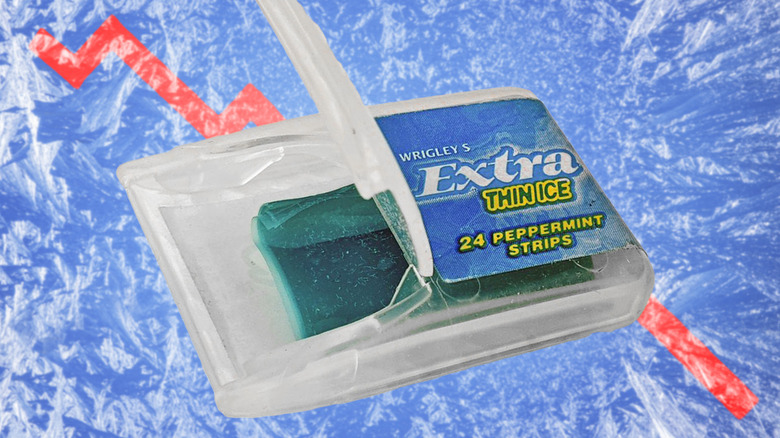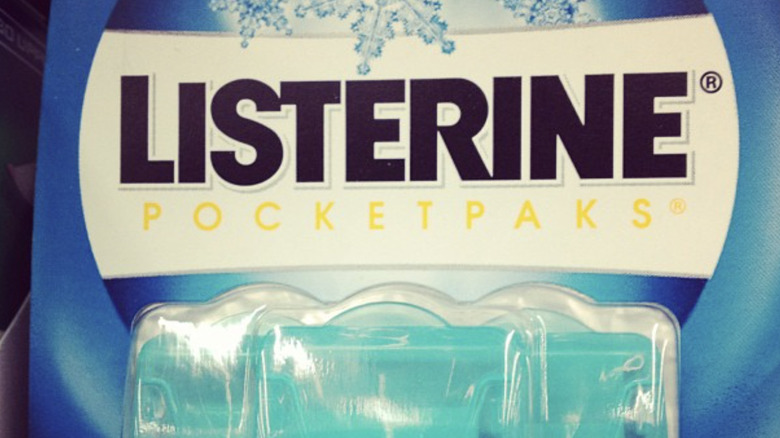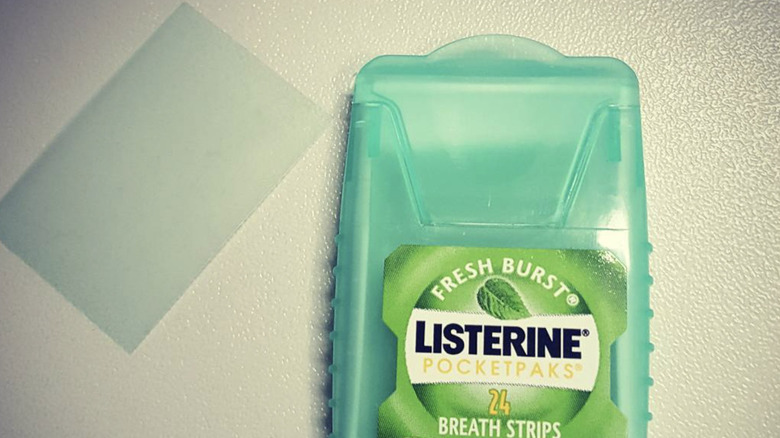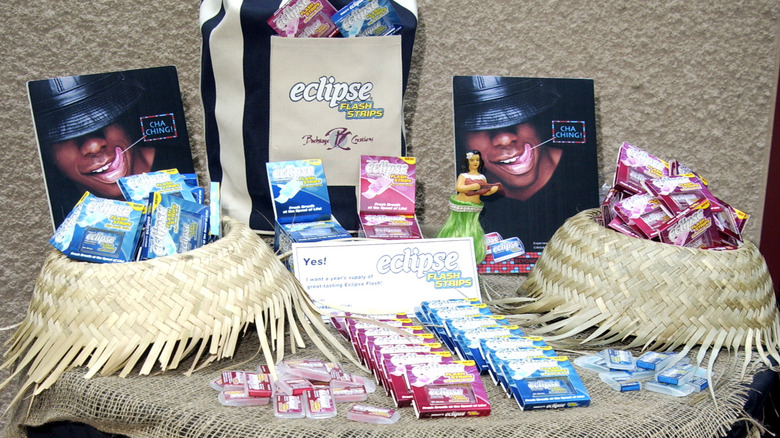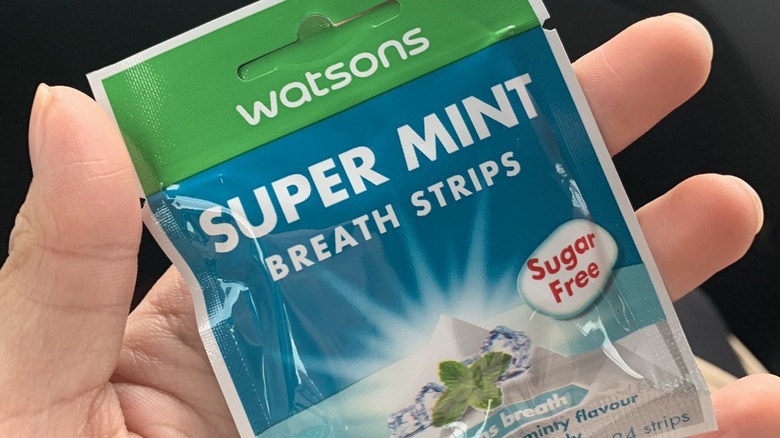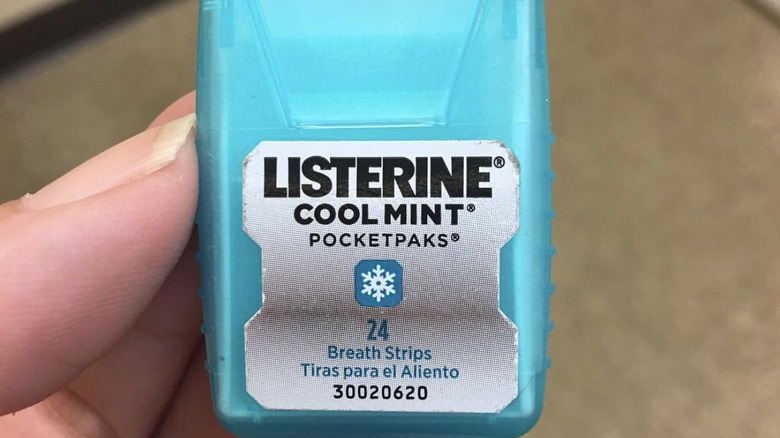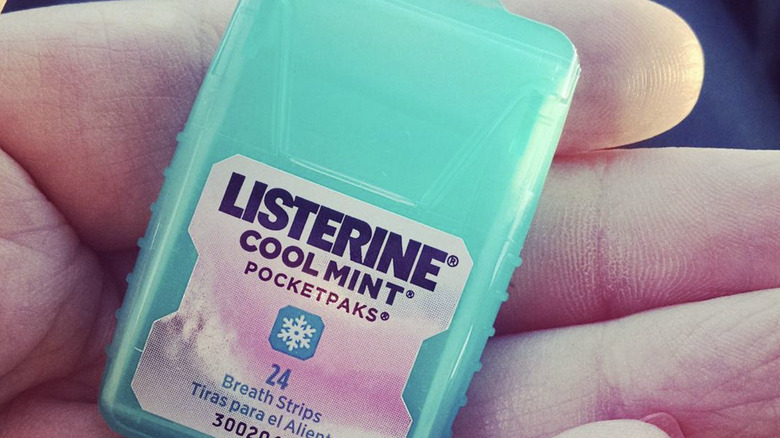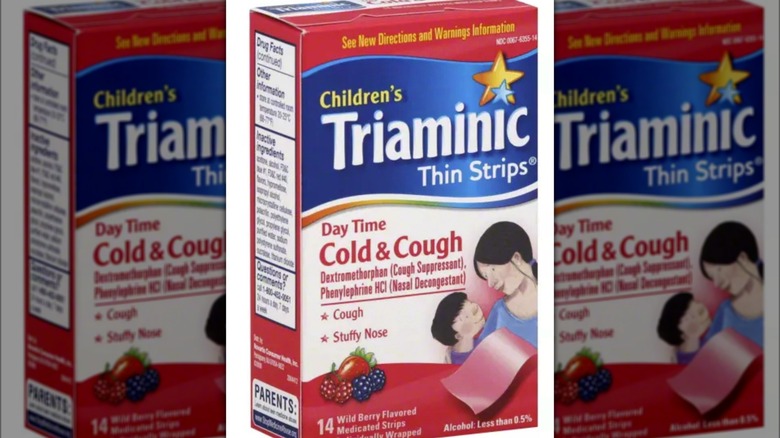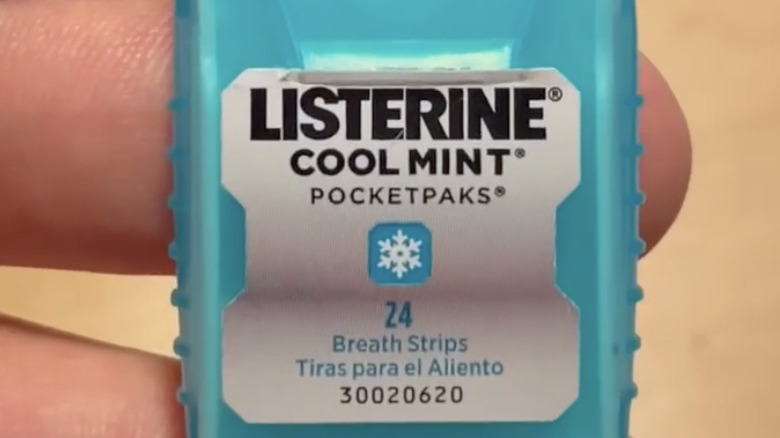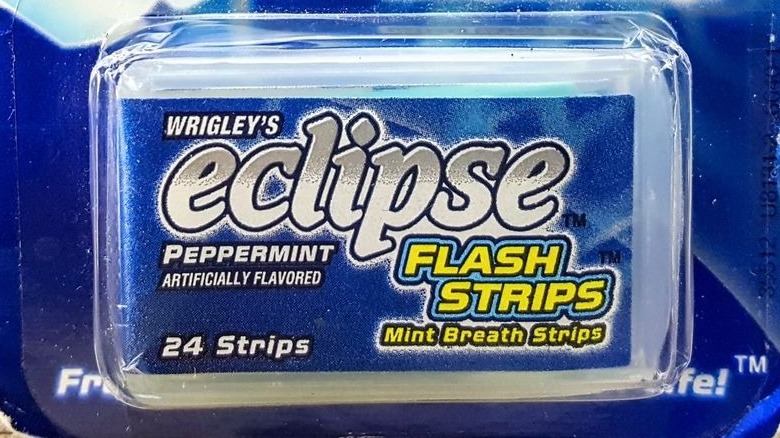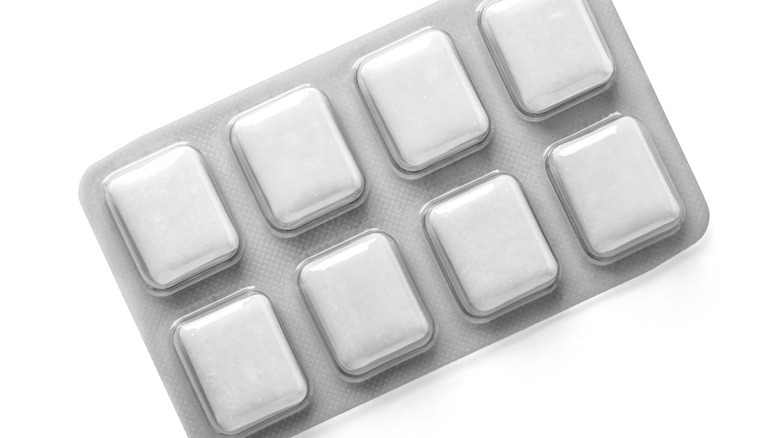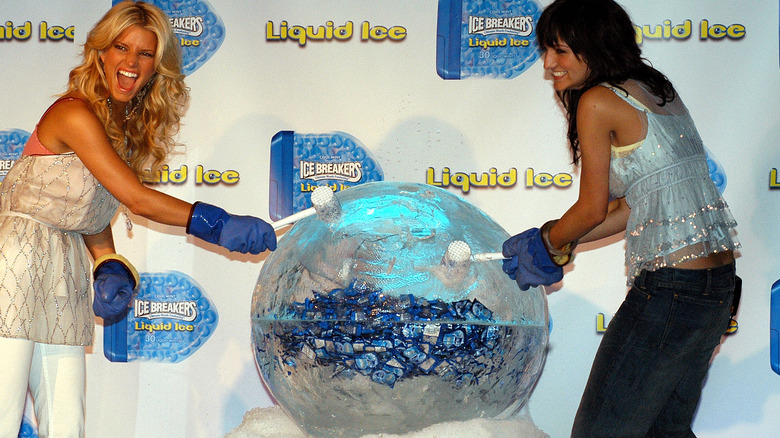The Rise And Fall Of Breath Strips
Consumers have a lot of choices when it comes to temporarily relieving or covering up bad breath. And they've got way more now than they did 20 years ago, thanks to the 2001 creation and subsequent influence of breath strips. Today, most every grocery, convenience, and discount store around sells a wide variety of mints, gums, and small bottles of mouthwash, and many other products with the same minty ingredients and purpose in mind. Still available, although with a little bit of searching required are breath strips, a very of its time relic of the 2000s. Upon the introduction of this product — inch-long plastic-like film that instantly dissolves on the tongue, offering a cleaner-feeling and nicer-smelling mouth with a speed and convenience unmatched by chewing gum (its original purpose might surprise you) — it reached massive popularity. But breath strips didn't exactly transform society or replace any well-established products. It proved to be little more than a trend, and one of the weirdest food trends in history, adjacent to the world of oral hygiene.
Here's a refreshing look into how this odd little bit of consumer-minded science became a craze so quickly, and how it dissolved out of favor almost as fast.
Listerine made the first breath strips in the U.S.
The market leader and the first-ever breath strip available anywhere was manufactured by Listerine, a mouthwash maker. Listerine was in need of a brand extension by the early 2000s, specifically to appeal to consumers in their twenties and younger, outside of its usual demographic of those in their thirties and forties. Parent company Pfizer was concerned that Listerine's was a brand name in decline, known only to older consumers because of its flagship product: antiseptic mouthwashes, marketed since the late 19th century, which are medicinal in taste and function.
After six years of planning and formulation, Listerine PocketPaks hit stores in Canada in the middle of 2000 and then American shops in October 2001. Because Listerine is one of the most famous names in oral hygiene, Pfizer marketed PocketPaks, or as they're more generically known, breath strips, as a portable mouthwash and a dental hygiene product. They were not a gum or an alternative to candies made with mint. "We call it 'oral care on the go,'" Dermot Boden, a vice president of oral care at Pfizer told the New York Times in 2002. "Obviously it's very difficult for people to walk down the street with a bottle of Listerine, take a swig, and spit it out."
The science behind how breath strips are made
While generating ideas on how to go about selling Listerine to younger customers, Keith Lerner, director of business development for Pfizer, the mouthwash's distributor, discovered a product made by Japanese company Hayashibara. It was a small, chemical-fortified strip of mouth-dissolving material. Placed on the tongue, it was marketed specifically as a breath-freshening agent for smokers. Pfizer executives authorized Lerner to license the concept and the science behind it, but it had to be transformed. "So we needed to improve the flavor substantially as well as the germ-killing benefit," Lerner told the New York Times. "We're not about masking germs; we're about killing them." In addition to adding the pleasant flavor of its Cool Mint Listerine mouthwash, Pfizer scientists laced its strips with the same four oils that serve as the active ingredients in the liquid product: thymol, methyl salicylate, menthol, and eucalyptol.
It took researchers at Pfizer six years to perfect the tech and recipe behind what would hit the market as Listerine PocketPaks. How it's done: Breath strips are manufactured by melting a polymer, sending it through a die, adding mint flavoring and the assortment of strong oils, then cooled to room temperature, and finally, machine-cut into strips.
Early marketing efforts were viral marketing attempts
In unveiling a product as different and groundbreaking as breath strips, Pfizer and Listerine introduced PocketPaks to the world with a slow, careful, and nontraditional marketing plan. Listerine Cool Mint PocketPaks reached stores in Canada in 2000 and in the U.S. in October 2001, and they sat on shelves without much of an advertising push. It wasn't until December 2001 that the first PocketPaks televised commercial debuted, the freshness of the strips illustrated by ocean waves crashing ashore, with the slogan "Kill the germs. Feel the clean."
Listerine also aggressively targeted a younger consumer base with PocketPaks by embracing pre-social media viral marketing techniques. Pfizer hired promo teams to hand out samples of the strips to attendees of the Chicago Film Festival and movie audiences in New York City. Then it took an influencer approach by giving them away to actors and celebrities arriving for the 2001 Emmy Awards, as well as to the entertainment reporters covering the event. Competitors followed Pfizer's lead on that front. Wrigley introduced its Eclipse Flash Strips in part by prominently displaying them and giving them away to attendees of the 2002 Teen Choice Awards.
Breath strips did big numbers
When Pfizer sent breath strips out into the world, marketed as Listerine PocketPaks, they were a rousing success and it was one of the most lucrative and well-received new product launches of the early 2000s. Initially sold in packages of 16, 24, and 72 strips and priced between $1.49 and $3.99, Pfizer shifted more than $100 million worth of those minty, disappearing films in their first 12 months of availability in the United States.
Pfizer claimed that one strip was designed to dissolve in just about four seconds and offer its full, breath-freshening and germ-killing powers for a period of 19 minutes. That promise, plus its low price point, made PocketPaks especially popular with younger Americans, something that proved consistent with Pfizer's intent to market Listerine to people under age 30. A ubiquitous presence in the pockets of younger Americans in 2002, Cool Mint Listerine PocketPaks couldn't be avoided but were also appreciated. Time named the breath-freshening product one of the best new inventions of 2002.
PocketPaks launched the breath strips craze
Before they appeared far and wide throughout American stores in 2001, Listerine-branded PocketPaks debuted without much fanfare, or marketing, in Canada in 2000. But breath-improving product makers noticed nevertheless. Sensing that breath strips were potentially about to be a very big and very lucrative sector of the market, other companies rushed their own copycat versions of PocketPaks into stores, which arrived around the same time as the PocketPaks U.S. launch in October 2001.
Many breath strips differentiated themselves with marketing that emphasized unique features. For example, Sugar-Free MagikStrips played up the product's no-sugar-added selling point, even though no strips contained caloric sweeteners. Vitech America's Minty! Instastripz, which preceded PocketPaks' American debut by five months, turned Listerine's name recognition and reputation against itself, promising customers that its breath strips offered a less medicinal taste than the one supposedly innate to PocketPaks. Primarily a gum manufacturer and worried about losing market share to a minty upstart, Wrigley unveiled Flash Strips, a dissolving film that cribbed from PocketPaks while also serving as a brand extension for its upmarket, extra-fresh gum brand, Eclipse.
Several pharmacies and variety stores unveiled store-brand and generic breath strips by the end of 2002. Walmart, Walgreens, CVS, and SavOn's strips competed in the quickly populated and increasingly crowded breath strip market by offering their takes for a lower price than the name brands could.
The packaging was innovative, too
How a product is presented to the public serves as initial, ground-level marketing. Because Listerine's PocketPaks represented a completely new product as far as American consumers were concerned, parent company Pfizer had to come up with a totally original form of packaging with which to ship and sell breath strips, one which had to be tiny, water-resistant (to prevent premature dissolution), and as hip and fresh-seeming as PocketPaks themselves.
With Ontario-based packaging firm Davis & Associates taking the lead, Pfizer helped to develop a mostly flat and rectangular hinged box roughly the size of a large coin. Internally referring to the container as a vial, this PocketPaks receptacle could be easily and unobtrusively stored in a pocket, and it met Pfizer's requirement that it could stay virtually the same size across products with different strip counts. Pfizer also wanted to play up its historic and recognizable Listerine branding while also keeping things modern and eye-catching. Davis & Associates obliged by placing the PocketPaks pack onto a printed, brightly styled cardboard blister, which could fit in amongst other purchases on candy and gum racks and register-adjacent displays.
Breath strips' popularity led to many other products
The science that made breath strips possible was such an inventive and potent delivery system that after Listerine PocketPaks and other breath aids arrived and peaked in popularity, manufacturers utilized the tech as a way to get pharmaceuticals into bodies as quickly and efficiently as possible. In 2007, a team of biomedical engineering students at Johns Hopkins University developed a breath strip-inspired product that delivered a vaccine for the rotavirus that didn't need refrigeration, unlike the traditional formulation of that medicine.
Makers of over-the-counter and prescription drugs alike embraced oral films as a new way to sell their wares. In the 2000s and 2010s, store shelves were graced with strip versions of the sleep aid melatonin, the nausea medicine zuplenz, the drug Gas-X (perhaps relieving the flatulence caused by beans), and Suboxone, a substance designed to help adults trying to break an addiction to opiates. Benadryl, Theraflu, and the children's cold medicine Triaminic all released (and then discontinued) strip versions of their well-known over-the-counter products. By 2020, even more meds could be found in an orally dissolving version, which treated conditions ranging from schizophrenia to migraines to excessive vomiting.
Breath strips disrupted the mint and gum industries
If the whole point of Listerine Cool Mint PocketPaks was to reposition the venerable and stodgy mouthwash as hip and new, and save the dying brand amidst increased competition from mints and gum, the strategy worked. Not only did the first major breath strip product generate more than $100 million in sales for Listerine's owner Pfizer in its first year, but it seemed to have redirected a lot of that money from mints and gum manufacturers. Over the span of 2001 and 2002, sales of breath mints fell by 2%, a dip attributable to the white-hot popularity of similarly-priced strips like PocketPaks. Altoids especially suffered during the breath strips craze; sales fell by a whopping 10% in that period.
Sales of gum, helped by the popularity of oral hygiene-oriented products, saw double-digit growth in 2001. When breath strip sales crested in 2002, they cut the rise of gum sales to under 10%. That reduction was also related to PocketPaks and other breath strips.
Breath strips were big in Europe, too
Growing into one of the world's biggest chewing gum companies after its 1891 start by a mysterious family, Wrigley only ever made chewing gum until 2002. That's the year it got in on the breath strips trend, because it seemed to be such a can't-miss proposition at the time. At the end of 2002, Wrigley, the company behind some of the most popular chewing gums available, announced that it would devote $50 million to launch a breath strip to compete with Listerine's PocketPaks. Those products: Winterfresh Thin Ice and Eclipse Flash Spearmint, the latter a brand extension of its line of supremely minty Eclipse gum. Both breath strips were instant hits — Wrigley reported a first quarter of 2003 growth rate of 12% and a 4% increase in global sales. That suggested high profits on just a little bit more product moved, a lot of that coming from its two new flagship breath strips.
The success would prove short-lived for Wrigley, at least in the United States. In October 2004, just two years after the flashy debut of Eclipse Flash, Wrigley shut down its strips factory in Arizona and moved operations to Poland. Sales of the strips had faltered in the U.S. but exploded in Europe. A reorganization in Poland meant that Wrigley could more quickly meet breath strip demand in Europe while also saving a fortune on shipping and tariffs.
Functional gums helped put breath strips away
Another new entry in the early 2000s world of science-minded consumables marketed as bad breath eliminators: functional gums. Positioned as high-end but accessible oral hygiene products to create separation from and elevation above candy-like mints and simple gums, functional gums came with dentist recommendations and a higher price tag, marketed as good for overall mouth health that treat the root causes of halitosis. That's a similar approach to the one Pfizer used when presenting PocketPaks, as it held up the breath strips as powerful, germ-eliminating Listerine in the form of a dissolvable film.
Such elaborate gums found a foothold in the marketplace — it was just gum, but seemingly easier to market, since consumers understand gum more than the newfangled and mysterious breath strip. The popularity of new gums led to a resurgence for gum in general, spelling the downfall (or fall into relative obscurity) of Listerine Cool Mint PocketPaks and their ilk.
Breath strips technology was repurposed for illicit drug delivery
In 2013, the United States Drug Enforcement Agency put out a call to parents to look for signs that their teenage children were buying, selling, or using a new illegal, synthetic recreational drug. Known by various names that reflect its chemical makeup — including 25I-NBOMe, 25C-NBOMe, 25B-NBOMe — but colloquially as N-Bomb or Smiles, the drug offered a potent hallucinogenic experience comparable to that of LSD with some of the effects of methamphetamine also observed. Commonly manufactured as a liquid and a powder, N-bomb appeared on law enforcement agencies' radar after authorities noticed that it was being distributed via dissolvable plastic strip, the powerful ingredients imbued in the same kind of film used to make mouthwash portable in products like Listerine's PocketPaks.
N-Bomb was particularly popular from 2011 to 2013 around Georgia, North and South Carolina, Minnesota, Wisconsin, and Louisiana, with most of the trade taking place via online channels. The DEA remained so concerned about the drug, which looked exactly like commonly available and mundane breath strips, that it lobbied for N-Bomb to be made illegal — a Class I controlled substance — and in 2020, issued another public warning about it.
Liquid mints replaced breath strips
After a heady, whirlwind period of about two years in which breath strips ruled the anti-bad-breath scene and added hundreds of millions of dollars to the coffers of big pharmaceutical companies, sales of Listerine PocketPaks and its brethren slowed and cooled. In the end, the product that once cut into the sales of gums and mints and replaced those durable items for many, enjoyed only temporary dominance. As the novelty of dissolving mouth strips wore off, consumers returned to their favorite mints and gums. Listerine PocketPaks remained in stores into the 2020s, sitting on shelves by the gums and mints as an option for breath-freshening, having not really permanently changed the game.
Breath strips were ultimately a fad, which come in hot and fast and disappear just as quickly. Sales were down by almost half in 2003. Freshness-seeking consumers moved on to the next craze in this realm: liquid mints, or drops. An established product in Europe by the mid-2000s, these tiny, rapidly dissolving capsules offered the same portability, functionality, and minty flavor as breath strips. But brands like Ice Breakers Liquid Ice could deliver the active ingredients in a more concentrated manner, and without the polymer film that needed to lay flat on the tongue.
